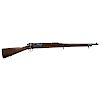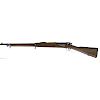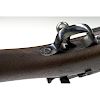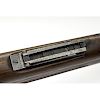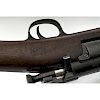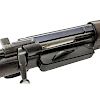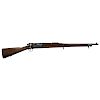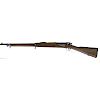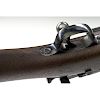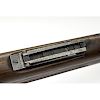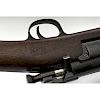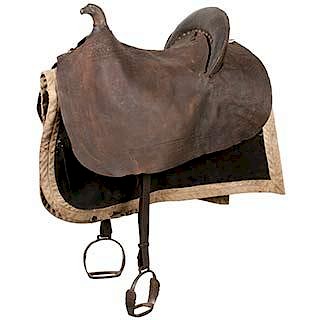**Springfield Model 1901 Krag Rifle With Pope Barrel
About Seller
6270 Este Ave.
Cincinnati , OH 45232
United States
With offices in Cincinnati, Cleveland and Denver, Cowan’s holds over 40 auctions each year, with annual sales exceeding $16M. We reach buyers around the globe, and take pride in our reputation for integrity, customer service and great results. A full-service house, Cowan’s Auctions specializes in Am...Read more
Two ways to bid:
- Leave a max absentee bid and the platform will bid on your behalf up to your maximum bid during the live auction.
- Bid live during the auction and your bids will be submitted real-time to the auctioneer.
Bid Increments
| Price | Bid Increment |
|---|---|
| $0 | $25 |
| $500 | $50 |
| $1,000 | $100 |
| $2,000 | $250 |
| $5,000 | $500 |
| $10,000 | $1,000 |
| $20,000 | $2,500 |
| $50,000 | $5,000 |
| $100,000 | $10,000 |
About Auction
Nov 1, 2017 - Nov 3, 2017
Cowan's Auctions dawnie@cowans.com
- Lot Description
.22 caliber, rare 26" barrel length, S/N 402882. Marked on the left side of the receiver Model 1898 Springfield Armory. Blue finish, walnut stock. The military stock is properly portioned for a 26" barrel. 1901 rear barrel sight. Stock is cartouche JSA/1902.
U.S. Springfield Krag M1898 Short Rifle with 26" Stevens Pope 22 caliber barrel.
Between 1901 and 1904, H.M. Pope joined a venture with The J. Stevens Arms Co. of Chicopee Falls, Mass. for production of a .22 caliber barrel to be retrofitted to U.S. Springfield Krag actions for small arms training purposes. Pope foresaw that a small caliber cartridge to be utilized for the U.S. military small arms training was needed because the cost of using a 30-40 cartridge for training purposes was cost prohibitive in the small unit field organizations' budgets. Stevens thus was able to create a possible demand for the Pope designed .22 barrel by marketing such to various militia/national guard units between 1903 and 1905.
Accordingly, in 1904, the Pennsylvania National Guard was the first state to recognize the advantages of a small caliber barrel for training purposes and placed an order for 100 barrels with Stevens. Thereafter, the Pennsylvania National Guard Chief of Ordnance notified/informed the U.S. Army Chief of Ordnance of the advantages to such an arm and also of the order with Stevens. Whereupon, the U.S. Army Chief of Ordnance advised that such was not authorized and such barrels should not be assembled to the Krag rifles. Apparently, this remonstration was unheeded not only by the national guard of Pennsylvania, but also by the national guards of Ohio, New Jersey and Washington who also placed orders with Stevens for the .22 caliber barrels. The exact number of barrels ordered and shipped to each of these states' national guard units and actually installed is unknown as well as whether they were all 30" rifle barrels. However, the presumption has been that all were 30" rifle barrels due to the preponderance of infantry as compared to cavalry national guard units. However, at least one 22" barrel has been reported and assembled on a carbine previously in the William R. Mook collection. Whether there were more carbine barrels fabricated, much less shipped and assembled, is unknown. With only one .22 barreled carbine surfacing in over 110 plus years it may very well be that the carbine assembled with a 22" .22 barrel was a prototype assembled by Stevens in an attempt to gain orders which marketing efforts may not have been successful.
Which brings us to this particular .22. This particular 'short rifle', S.N. 02892, has an original Stevens Pope 26" barrel and not a 'cut-down' 30" rifle barrel retrofitted to a M1898 Krag rifle. IT is marked "H.M. Pop" on the left side of the barrel near the breech end under the wood. The cartouche of "1902" matches the serial number range for production and the original assembly of this rifle as a 30-40 caliber weapon in Fiscal Year 1902. However, because of the shortened barrel, the stock forearm has been altered/cut-down to accommodate the barrel reduction. A wood filler was then added to cover the exposed lightening cut in the stock bed evident from the shortening. This was similar to the process utilized in the production/fabrication of the U.S. Magazine Carbine caliber .30 Model of 1899, altered for Knife/Bayonet and Sling, commonly referred to as the Philippine Constabulary rifle. However, the upper band of this 26" 'short rifle' was not routed for the larger barrel diameter occasioned by moving the upper band rearward on the stock as was done with the Philippine Constabulary conversions. Thus, it is surmised that the existing upper band was not modified apparently as an effort to make the whole process of conversion to the 26" barrel from a 30-40 barrel easier with less steps and effort involved at the state national guard unit armories level. Additionally, the muzzle of this 26" barrel is crowned like the original 30-40 Krag rifles and carbines and therefore unlike the Stevens-Pope 30" rifle barrels which were square cut on the muzzle. Why the difference between the barrels is unknown. Conjecture is that it was an easy way to identify the 30" Stevens rifle barrel from the 26" 'short rifle' barrel or to make the 26" barrel look more like a 30-40 Krag barrel and similar to the Board of Ordnance and Fortifications rifles with 26" barrel tested by the Springfield Armory between 1901 and 1903.
Thus, the fabrication of this 26" .22 barrel may have been an additional attempt by Stevens to market another .22 barrel using relatively inexpensive ammunition that could be assembled and used by the National Guard, the regular U.S. military, high schools, military schools, and/or private colleges for training purposes. The timing of the attempt to produce a .22 barrel that could be used in National Guard units with the testing and fabrication of Krag rifles, carbines and 'short rifles' by Springfield Armory (Philippine Constabulary and Board of Ordnance and Fortifications Rifles) for shorter stature individuals appears to be too coincidental to dismiss this 26" .22 'short rifle' as not being assembled by Stevens as a prototype of small caliber rifle to gain orders for a .22 26" training barrel. As such, it would be in the same category as the .22 carbine in the Mook collection and may be one of a kind or the only one known presently in existence.
The history of the acquisition will be gladly furnished upon inquiry.
**Requires C&R or FFLEliminate the Hassle of Third-Party Shippers: Let Cowan's Ship Directly To You!Condition
If you'd like a shipping estimate before the auction, contact Cowan's in-house shipping department at shipping@cowans.com or 513.871.1670 x219. - Shipping Info
-
Eliminate the Hassle of Third-Party Shippers: Let Cowan's Ship Directly To You!
If you'd like a shipping estimate before the auction, contact Cowan's in-house shipping department at shipping@cowans.com or 513.871.1670 x219.
At the request of the buyer, Cowan's will authorize the shipment of purchased items. Shipments usually occur within two weeks after payment has been received. Shipment is generally made via UPS Ground service. Unless buyer gives special instructions, the shipping method shall be at the sole discretion of Cowan's Auctions, Inc.. Cowan's is in no way responsible for the acts or omissions of independent handlers, packers or shippers of purchased items or for any loss, damage or delay from the packing or shipping of any property.
-
- Buyer's Premium



 EUR
EUR CAD
CAD AUD
AUD GBP
GBP MXN
MXN HKD
HKD CNY
CNY MYR
MYR SEK
SEK SGD
SGD CHF
CHF THB
THB
